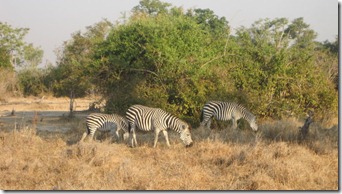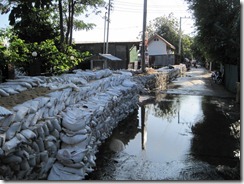My family humored me and let me take them on a two-day adventure to the Chaco, Paraguay’s western rural area. We drove on Friday afternoon to Filadelfia, a town about five hours northwest of Asuncion not far off the Trans-Chaco Highway. I’ll write more about the adventure tomorrow, but let me leave with you some background on this place one could call "the wild west" of South America.
Filadelfia, as is many towns in that part of Paraguay, was founded by the Mennonites, a Christian denomination, in the 1930’s. The Mennonites, who emigrated from Prussia (now a part of Germany) to Russia in the 1760’s and 1770’s, migrated en masse to Paraguay in 1929 (as well as the United States and Canada) following persecution and explusion from the Soviet Union. The Paraguayan government granted several large land parcels to the Mennonites, particularly in the Chaco, where the government hoped to solidify Paraguay’s hold on a large section of the country with few people. Life was very difficult for the early Mennonites as they domesticated the wild Chaco — a fairly inhospitable place with little rainfall and poor soil. Several indigenous groups — Guaranis and others — lived as hunterers and gatherers in the Chaco, and many resisted encroachment by their new neighbors. The Mennonites and indigenous continue to co-exist, and many indigenous now work for Mennonite enterprises. After years of fighting poor agriculture conditions and surviving threats from the indigenous and poisonous, the Mennonites shaped this part of Paraguay into what is now the country’s breadbasket. Mennonite families live on large, square estancias parceled out between former Mennonite colonias such as Filadelfia now incorporated as Paraguayan towns. The area has a large network of unpaved roads criss-crossing the Chaco maintained by the Mennonites.
The Mennonite’s "Cooperativa" is one of Paraguay’s largest business operations. Each year, the "Cooperativa" produces much of Paraguay’s meat and dairy products as well as foodstuffs (the "Cooperativa" also exports some of its products overseas, particularly beef and peanut oil). The "Cooperativa" also provides the area with a multitude of services, including hotels, restaurants, gas stations, hospitals, pharmacies, and shopping centers. If ever there were an example of monopoly, the "Cooperativa" would be it. The enterprise’s operation and logistics network is nothing short of amazing. It provides feed for animals, trucks raw milk to milk factories, turns milk and other foodstuffs into processed goods, and ships it to markets. I was amazed to see how comprehensive and efficient the Mennonites’ "Cooperativa" is in helping Mennonites — and many indigenous — earn a living and providing them with a quality of life much better than would be possible if they didn’t work together to survive and flourish.
The Mennonite culture in this area is interesting. We saw many tall, blond people of Germanic descent walking the streets. "Plattdeutsch," an old variant of German, is the common language, although Spanish and Guarani are also prevalent. I noticed a cultural divide between the Mennonites and the non-Mennonites (mostly indigenous) in the communities we visited, including Filadelfia, Colonia Neuland, and Loma Plata. I noted a cultural divide between the Mennonites, who seemed to be more affluent, and other Paraguayans. As a result, the two groups seemed to frequent different locations (e.g. different restaurants and grocery stores). While not overt, it was not difficult for an outsider like me to pick up on this cultural separation.




